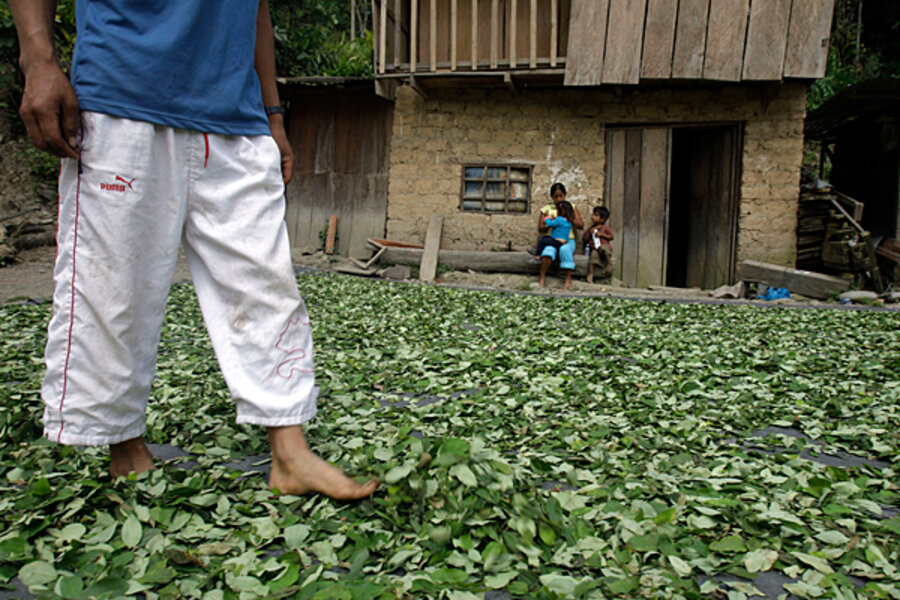Colombia out, Peru in, as coca king. What's that mean?
Loading...
| BOGOTA, Colombia
Colombia is no longer king.
After nearly two decades as the top producer of coca, the main ingredient in cocaine, Colombia has passed the baton to neighboring Peru, according to United Nations figures. It’s a shift in the map of Andean coca production, which experts say strongly resembles the landscape from the early 1990s, a time of expanding drug crop cultivation and trafficking.
The UN Office on Drugs and Crime announced Tuesday that 60,400 hectares of coca were planted last year in Peru. Although this is a 3.4 percent drop in the area cultivated from the previous year, a 25 percent drop in Colombia means Peru has taken on the dubious distinction of top producer.
"The new map looks an awful lot like the old map" from the 1990s, says Adam Isacson, an analyst with the Washington Office on Latin America who has been tracking drug policy in the Andes for more than a decade.
In 1992 it was estimated that Peru produced 60 percent of the world's coca. But around that time cultivation began shifting to Colombia in part because a fungus devastated crops in the Upper Huallaga Valley, but also because of an aggressive shoot-down policy on drug-laden planes flying in Peru. By 2000, 163,000 hectares of land were under coca cultivation in Colombia, which produced nearly 90 percent of the world's cocaine supply.
Plan Colombia, the massive US program to help Colombia fight drug production and rebels who profit from them, provided helicopters, planes and pilots for aerial fumigation of coca crops, and billions of dollars in aid.
Though fumigation and forced eradication policies are sharply criticized for their repressive nature, today Colombia's coca crop is just 48,000 hectares, according to UN estimates for 2012, 20 percent less than Peru's. Bolivia is the number three producer with 25,300 hectares under cultivation.
But as Colombia's aggressive push against coca in its own territory expanded in the 2000s, UN monitors began seeing a new shift of coca cultivation back to Peru, in what many drug war analysts call the balloon effect: when pressure is applied in one coca growing area, production “balloons” in another.
"The carrousel has come full circle," says Ricardo Soberón, former head of Peru's drug policy office and now a researcher with the Drugs and Human Rights think tank in Lima.
But the growth of Peru's importance as a coca grower can also be explained by shifting markets for cocaine. The United States remains the largest market worldwide for the drug and US officials estimate 80 percent of the cocaine that hits US streets is Colombian. But Brazil, with a booming middle class, has become the world's second largest market, and together with Argentina it is an important transshipment point for Europe.
"Geographically, Peru and Bolivia make more sense as sources for those markets," says Jerry McDermott, director of Insight Crime, an organization devoted to studying organized crime in Latin America.
How to fight trafficking in Colombia?
Despite Colombia's drastic reduction of coca acreage, the country is still struggling with how to fight the problem.
At a forum this week in Bogotá, drug policy analysts, coca growers, and farmers drafted proposals on how to deal with drug crops and trafficking in the country. The goal was to send options to negotiators from the Colombian government and leftist FARC rebels currently discussing how to end the country's 50-year-old conflict. The drugs issue is one of six points on the peace talk agenda.
The Revolutionary Armed Forces of Colombia (FARC) has largely funded its war over the past two decades with proceeds from the drug trade, with an estimated value of anywhere from $200 million to $3.5 billion.
At an event on the sidelines of the UN General Assembly in New York, President Juan Manuel Santos called on the FARC to "switch sides" and become allies in the fight against drug trafficking. "Can you imagine if the FARC instead of protecting [coca] fields would help to control drug trafficking?" President Santos asked.
FARC negotiators blasted Santos' comments in a statement, saying that he was trying to "place on the shoulders of the guerrillas the responsibility for the existence of drug trafficking in Colombia." The real reason for its existence in the country is the neglect of the state in rural areas and the thirst for drugs in the US, the FARC said.
While rebel commanders have historically acknowledged that the FARC "tax" coca leaf production, the leadership has denied it is involved in trafficking and in a message to delegates at the forum in Bogota, the Marxist-minded group said they "condemn narco-trafficking" as the ultimate expression of capitalism.
The FARC and government negotiators have been engaged in peace talks since last November but have reached a partial agreement only on the issue of rural development. Negotiators are currently discussing the future political participation of demobilized guerrillas and issues like victims rights, drugs, and disarmament.







